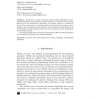36 search results - page 1 / 8 » Disfluencies, language comprehension, and Tree Adjoining Gra... |
103
click to vote
COGSCI
2004
15 years 5 days ago
2004
Disfluencies include editing terms such as uh and um as well as repeats and revisions. Little is known about how disfluencies are processed, and there has been next to no research...
109
click to vote
ACL
2012
13 years 2 months ago
2012
Recently, it was shown (KUHLMANN, SATTA: Tree-adjoining grammars are not closed under strong lexicalization. Comput. Linguist., 2012) that finitely ambiguous tree adjoining gramm...
105
click to vote
GRAMMARS
2000
15 years 3 days ago
2000
Abstract. We propose a modular design of tabular parsing algorithms for treeadjoining languages. The modularity is made possible by a separation of the parsing strategy from the me...
IJCAI
2001
15 years 1 months ago
2001
In this paper, we present a quantitative comparison between the syntactic structures of three languages: English, Chinese and Korean. This is made possible by first extracting Lex...
COLING
1994
15 years 1 months ago
1994
This paper presents the XTAG system, a grammar development tool based on the Tree Adjoining Grammar (TAG) formalism that includes a wide-coverage syntactic grammar for English. Th...

